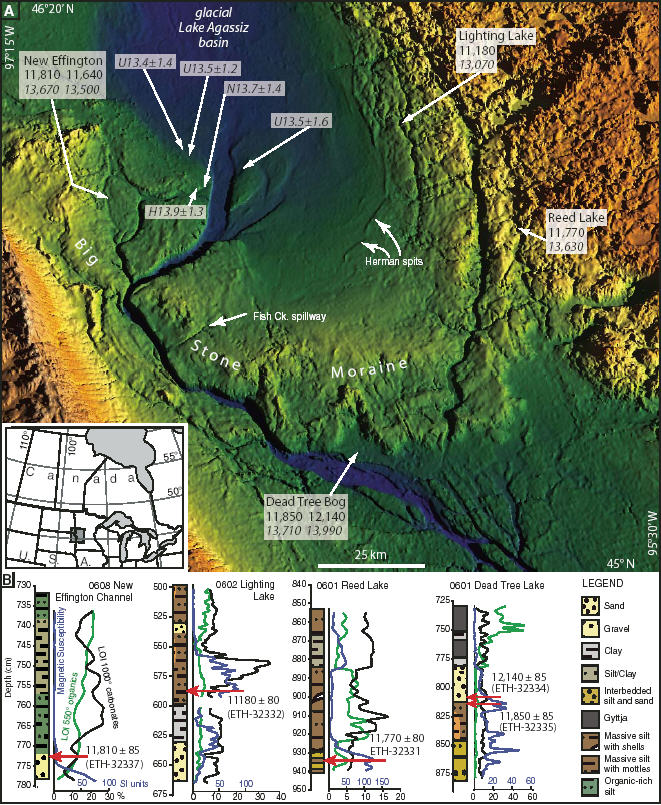If you've never heard of Lake Agassiz, it's no surprise. It disappeared over 8,000 years ago. Yet it may have been the global warming trigger that ended the last Ice Age.
Using remains from lakes, bogs and channels, a multi-disciplinary group of scientists recently tackled the secrets of glacial Lake Agassiz and Big Stone Moraine.
Knowing the chronology of glacier retreat, and when glacial lakes formed, is important in linking physical events on the landscape with paleoclimate records. At the close of the last ice age, glacial ice in the upper Midwest of the United States retreated very quickly, likely in response to the warming climate.
That retreating ice paused near the junction of Minnesota, North Dakota, and South Dakota long enough to form the Big Stone Moraine, which today is part of the subcontinental drainage divide between the Gulf of Mexico and Hudson Bay. After the ice sheet retreated from this moraine, the world’s largest freshwater lake, glacial Lake Agassiz, began forming.

Although this lake disappeared about 8,200 years ago, its presence has been known for well over a century — its sediments formed the rich farmland in the Red River Valley. We know its ending, but what about its beginning? And what can it teach us about what global warming has in store today?
"We know from various records that there were episodes of warming and cooling associated with the ice ages, and that a dramatic warming event (the end of the Younger Dryas cold period) was a dramatic example of rapid warming," said University of Toledo Professor of Geology Timothy Fisher. "It has been suggested for a while that a diversion of drainage from Lake Agassiz caused the cooling that led to the Younger Dryas (YD) cold period. If we can ascertain that Lake Agassiz was involved in the cooling, then another diversion of drainage might, in some way, be associated with the warming at the end of the YD.
"If Lake Agassiz is implicated in causing climate changes, then one can ask if today there are large bodies of water than could potentially affect oceanic circulation and thus climate."
To help understand the beginning, and maybe the end, of Lake Agassiz they needed to use methods unavailable in prior studies. Previous research used correlation but the researchers were able to extract sediment cores from the Big Stone Moraine and then do both radiocarbon and optically stimulated luminescence ( OSL) analysis.
They began by 'bracketing' the age of the moraine using shallow lakes in top and in front. New Effington Lake is a scoured out depression from the base of a meltwater channel that carried water over the moraine so it must be younger while the oldest piece of wood from the lake is a brackets the other end.
"Because there were no small lakes to core behind the moraine, we used OSL techniques to determine how old the beaches are that are cut into the moraine (and thus are younger than the moraine), " said Fisher. "The age of the oldest beach, within errors, was the same as the when New Effington lake formed, both recording a drop from about the highest lake level in Lake Agassiz, and providing the first ages for the beginning of Lake Agassiz."
What if future study reveals Lake Agassiz was not the trigger to the end of the last Ice Age?
"If Lake Agassiz is not implicated in climate change, then more work needs to be done to determine what did cause past changes in order to better predict or understand the triggers that could cause future ones."
The full study, including the radiocarbon and OSL results of the research by Fisher and Lepper, et al, can be found in the July issue of Geology.





Comments